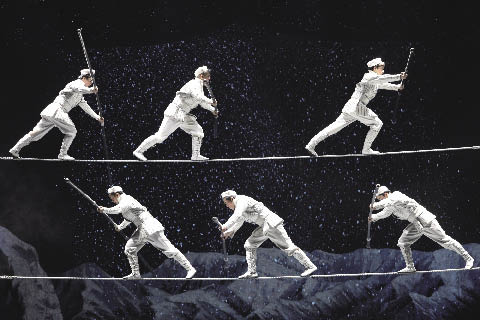Darwaz Art: Airing the Daring
Breathtaking and record-breaking acrobatics on the tightrope
By staff reporter XING WEN
IN Darwaz a misstep means certain death. The word is straightforward, meaning "walking on a rope in the air" in the Uygur language. Tightrope walking is a traditional sport of this ethnic group in China.
It was on July 5, 2009 that two Darwaz artists were on a wire set at an altitude of 1,607 meters above sea level between two mountains in Kanas, Xinjiang Uygur Autonomous Region. Inching across its 1,530-meter span were China's king of the tightrope, Ahdili, and his apprentice. Their performance was punctuated by various breathtaking mid air maneuvers.
Opening the act, Ahdili started from his end and walked backwards to the other before turning around and walking towards the center of the valley. His disciple then made his way from the other end towards Ahdili's starting point. When they met in the middle, to the terror of every onlooker, Ahdili decided to pass his partner by stepping on his chest as he lay back against the wire. Their success – in high winds – created two Guinness World Records: the first for walking at the highest altitude ever accomplished, and the second for doing it while passing each other on the wire.
This is not the first world record set by Darwaz artists. This traditional folk acrobatic art keeps its vitality even in the modern era of Cirque du Soleil and other reinventions of "the big top" and its stunts.
 |
|
Darwaz is a traditional sport of the Uygur ethnic group in China. |
Ancient Roots of the High Wire
Darwaz originated in China's Western Regions more than 2,000 years ago and was commonly practiced by the Uygur ethnic group of southern Xinjiang.
In Uygur myth, a flying monster was believed to wreak havoc on people's lives by controlling the forces of nature. To rid the people of this scourge, a young man set up a 30-meter-long pole, with a 60-meter-long rope stretched obliquely from the top of the pole to the ground. The young man walked on the rope to battle the monster aloft. After a fierce struggle, the airborn devil was finally slain.
To celebrate the victory and commemorate their hero, people learnt to master this skill and passed it down as a popular sport event. Some of them even went westwards along the Silk Road, performing the Darwaz art in India, Egypt and other places around the Red Sea. Nowadays, its performance has become an essential part of festive occasions and is well-preserved as a national intangible cultural heritage in China.
Darwaz is similar to high wire acts, but requires a lot more of the artists' courage and skill since it is performed without any safety belt, or a safety net, on a sloped tightrope dozens of meters above the ground.
Women were not allowed to perform Darwaz in the old days. However, as time went by, women gradually achieved equal status to male artists. During grand festivals and celebrations, Darwaz performers of both genders put on a show accompanied by cheerful folk songs. Holding a six-meter balancing bar, the performers walk, jump and even wrestle on the tightrope.
Performers are capable of keeping their balance just according to the feel of the wire on their soles, for they train barefoot from a very young age. To them, performing on the tightrope seems no different from doing it on the ground. But to the onlookers, it is breathtaking, an extremely exciting spectator sport. While watching Darwaz, onlookers sing folk ballads with traditional tambourine accompaniment, as a way to cheer on the performers. Uygur folk songs are renowned for their beautiful melodies, huge variety and earthy lyrics that convey the life and values of local culture.
With musical backup, the performers walk with ease both forwards and backwards, even when blindfolded. Sometimes they lay down the balance bar to execute handstands, juggling sequences or somersaults. Suddenly, the performer misses a step and is falling! Audiences are aghast, one great indrawn breath. But the performer falls expertly – on the rope, then waves to people and the show goes on. It is all just part of the act, and the entire audience is still in the palm of their hands.
The essence of the Darwaz art lies in moving beyond your expectations and imagination. Apart from traditional skills, today's Darwaz artists have practiced new stunts like jump rope and fencing on the high wire.
| 